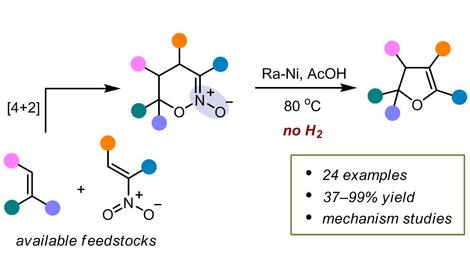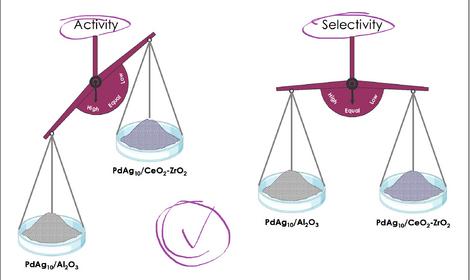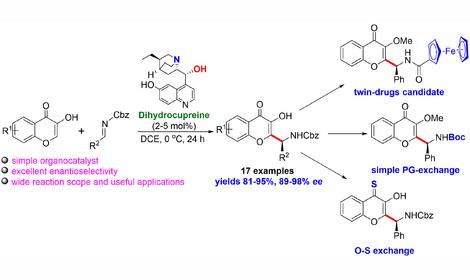Laboratory of Catalysis by Transition Metals and their Compounds (N38)

Head: DSc (Chem.) Victor M. Kogan (e-mail: : vmkioc.ac.ru, phone:+7 (499) 137-6739)
The laboratory was founded in 1967 by Prof. O.S. Chizhov who headed it until 1992. In 1992-2011 Laboratory was headed by Prof. S.P. Kolesnikov.
Research areas
Heterogeneous catalysis by transition metals and their sulphides, oxides and phosphides supported on conventional and non-conventional carriers. Design of novel nano-structured hydrotreating catalysts for the production of environmentally clean motor fuels.
Investigation into mechanisms of the formation and operation of active sites of catalysts in hydrogenation, hydrogenolysis, oxidative dehydrogenation, and in other model and commercially important reactions.
Synthesis and analytical studies of structures and investigations into mechanisms of the conversion of organic and organometallic compounds using IR spectroscopy, ICP-MS, and radioisotopic methods.
Main results
A new mechanistic model for molybdenum sulfide catalysts with cobalt and nickel promoters under the hydrodesulfurization conditions is proposed. It includes dynamic migration of sulfur and promoter atoms between adjacent sulfide layers. The migrations are caused by heterolytic dissociation of gas-phase hydrogen and by the formation of hydride hydrogen on the promoter atom. Hydride hydrogen adsorbed on a promoter induces an electron density transfer from the bonding promoter to Mo, changing its catalytic activity. The proposed concept of dynamic migrations provides a new interpretation of the ''rim-edge'' model based on the formation of two types of active sites: highly active (''rapid'') and less active (''slow'') sites. The ''slow'' sites are supposed to be associated with a non-promoted cluster on the edge of the MoS2 slab layer (''rim'') that catalyzes hydrogenation. The ''rapid'' sites are likely to be associated with a combination of promoted and non-promoted clusters on edges of the same (type I) or adjacent (type II) MoS2 layers. The ''rapid'' sites catalyze the C-S bond hydrogenolysis. Adsorbed hydrogen induces migration of sulfur and promoter atoms between adjacent clusters. This dynamic migration causes a transformation of ''rapid'' into ''slow'' sites and vice versa and, therefore, influences catalytic activity. Migration of Co or Ni promoter atoms to Mo sites on the rim is more likely than to Mo sites on the edge of Co(Ni)MoS layers because the former can accept promoter atoms from both upper and lower layers. The proposed model provides critical information for a rational design of improved hydrotreating catalysts and selection of preferred catalytic reaction conditions for various types of hydrocarbon feedstock through the optimization of the density and ratio of ''rapid'' and ''slow'' catalyst active sites. (V.M. Kogan)
The effect of the intermediate activated carbon covering the alumina carrier on catalytic activity of supported transition metal sulfides (TMS) prepared from heteropolycompounds (HPCs) in thiophene hydrodesulfurization (HDS), benzene hydrogenation (HYD) and hydrotreating (including HDS of S-containing and HYD of polyaromatic compounds) of diesel oil fractions was investigated. The carbon content on the alumina carrier varied from 0 to 3.8 wt.%. It was found that the carbon coating structure on the alumina surface changed depending on the presence/absence of the active phase on intermediate activated carbon. Total catalytic activity of catalysts in HDS and HYD reactions was maximal for the carbon content 1-2 wt.% and dropped for catalysts with 3.8 wt.% of carbon. Specific catalytic activity grew proportionally to the carbon content on the catalyst. Experimental data shows that a rise of the reaction temperature leads to a decrease in the amount of adsorbed hydrogen whose deficiency limits the H2S generation. It was supposed that the intermediate carbon placed between the alumina carrier and the active phase would accumulate hydrogen inside carbon pores. Besides, the intermediate C-carrier of the catalysts synthesized from Co(Ni) salts of heteropolycompounds promotes a stacking number rise in nano-slabs of the active CoMoS phase of the second type (in cooperation with Samara State Technical University).
The effect of the Co/Mo ratio in hydrotreating CoMo/Al2O3 catalysts prepared by a simultaneous use of Ñî2Ìî10HPA (heteropolyacids) and cobalt citrate was investigated. Catalysts with XMo6(S)/Al2O3 and Ni3-XMo6(S)/Al2O3 structures were prepared from heteropolycompounds (HPCs) of the Anderson type (where X= Co, Ni, Cr, Mn, Fe, Cu, Zn, Ga). The precursors and synthesized catalysts were characterized by FTIR, XRD, EXAFS, and HRTEM techniques. The prepared catalysts were examined in model reactions of thiophene HDS and benzene HYD and in hydrotreating (HDT) of diesel fraction. Correlations between catalytic activities in HDS and HYD and thiophene adsorption heats depending on the heteroatom’s nature prove its important role in the formation and behavior of HYD and HDS active sites. It was found that heteropolycompounds were effective precursors of the multilayered active phase of hydrotreating catalysts (in cooperation with Samara State Technical University).
The effect from a mixture of 10 mol% H2S and H2 used to passivate a Ni2P/MCM 41 catalyst was studied. H2S passivation was found to be superior to conventional O2 passivation because it gave higher HDS activity and required no post re-reduction. The results showed that phosphide catalysts exhibited better catalytic properties as compared to conventional supported transitional metal sulfides. In the course of the reaction sulfur covers only top layers of phosphides and do not penetrated into deep layers. A role of surface sulfur and of active sites was studied. A new method for passivation and reactivation of phosphide catalysts was suggested. The H2 plasma reduction procedure ensures a more energy- and time-efficient way to synthesize metal phosphides without excess phosphorous in the precursors (in cooperation with Dalian Technical University, Dalian, People’s Republic of China).
More extensive consumption of low quality crude oil in refinery demands new generation catalysts to provide comprehensive hydro refining of the hydrocarbon fraction. A technology was developed for the preparation of catalysts based on mesoporous titanium silicate Ti0.03Si0.97O2 with NiO nano-crystals (4.1-4.7 nm) incorporated in pores. Two methods were suggested for the preparation of composite catalytic systems: first, the NiO phase was formed directly in pores of titanium silicate from micro-emulsion; second, NiO crystallites were prepared by cryo-processing of initial colloid and incorporated as micro suspension in Ti0.03Si0.97O2 pores. In the latter case, new bonds were found between silicate and NiO evidencing the formation of a material with new physicochemical properties. HDS and HYD activity of the composite system prepared from cryo-gel is higher than that of the system prepared by a conventional method (in cooperation with Baikov Institute of Metallurgy RAS).
The first methods were developed for introducing tantalum(V) into Mg-Al hydrotalcites, which are precursors of oxide catalysts for oxydehydrogenation of hydrocarbons and alcohols. Samples of oxide tantalum(V)-containing catalysts were synthesized. Their catalytic properties were studied in oxydehydrogenation of ethane to ethylene and ethylbenzene to styrene, oxydehydrocyclization of octane to ethylbenzene and styrene, and oxydehydrogenation of sec-butanol to ketone (octan-2-one). The transformation of ethane to ethylene over the tantalum-containing catalyst occurs with high selectivity (92-97%) at relatively low temperatures (500°C), and the catalyst is quite efficient in the conversions of ethylbenzene to styrene, dehydrocyclization of n-octane to ethylbenzene and styrene, and oxydehydrogenation of sec-butanol to octan-2-one. A comparison with a niobium-containing catalyst shows that it ensures higher yields and selectivities in similar reactions than its tantalum-containing analog (in cooperation with Kurnakov Institute of General and Inorganic Chemistry).
Findings of a DRIFT study of carbon monoxide molecular adsorption and hydrogen dissociative adsorption on gallium-modified mordenite and MFI (ZSM-5) zeolites show that in reduced gallium-modified mordenite (Ga-MOR) exchange cations both of Ga3+ and of Ga+ are present and detectable by CO adsorption. Ga3+ cations in Ga-MOR dissociatively adsorb molecular hydrogen at elevated temperatures, which results in the formation of gallium hydride species and acidic hydroxyl groups. In reduced Ga-MFI evacuated at 823 K under medium vacuum conditions, only intrazeolite exchange cations of Ga+ were detected. However intrazeolite exchange cations of Ga3+, which form upon high-temperature disproportionation of Ga+ cations in the reduced Ga-MFI and Ga-MOR, can be stabilized by high temperature oxidation of the zeolites.





